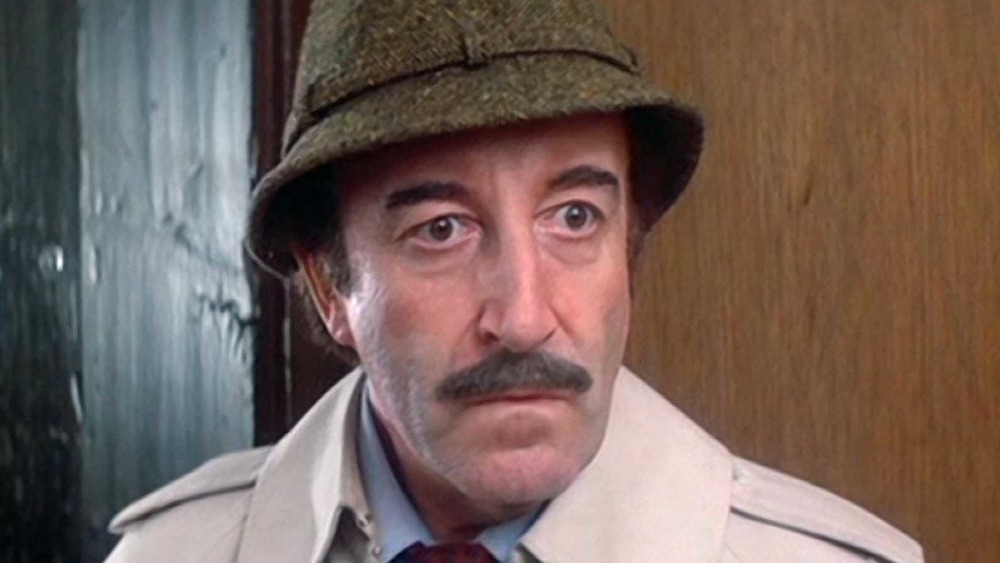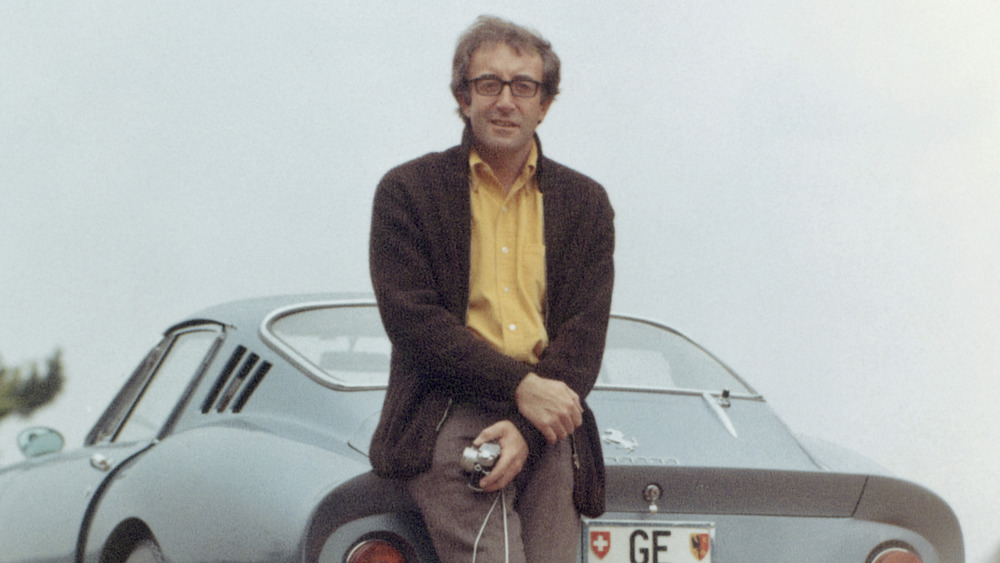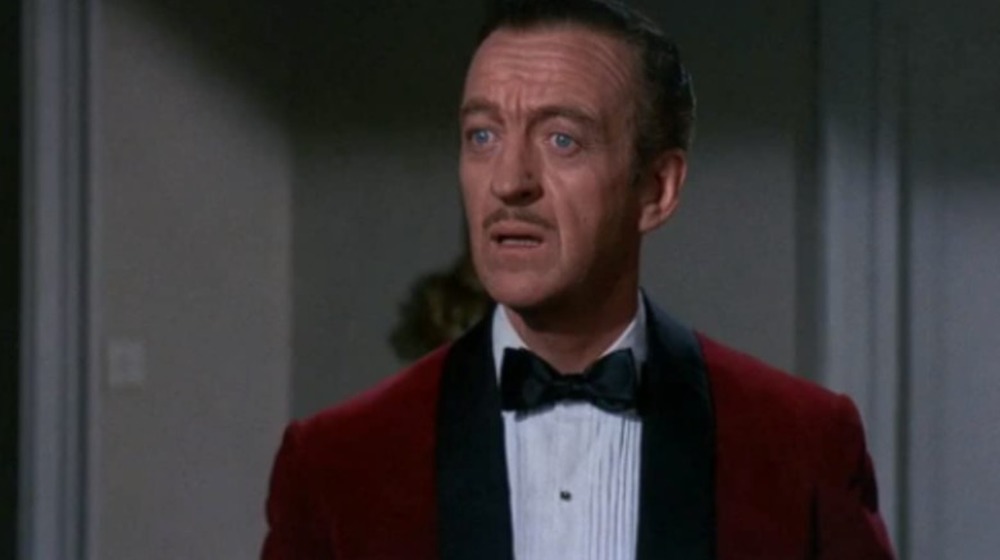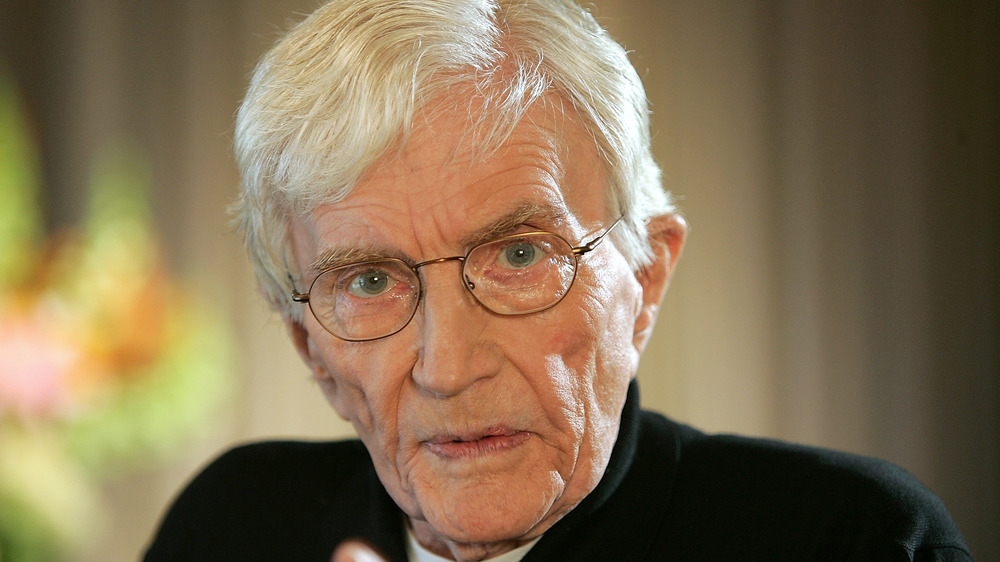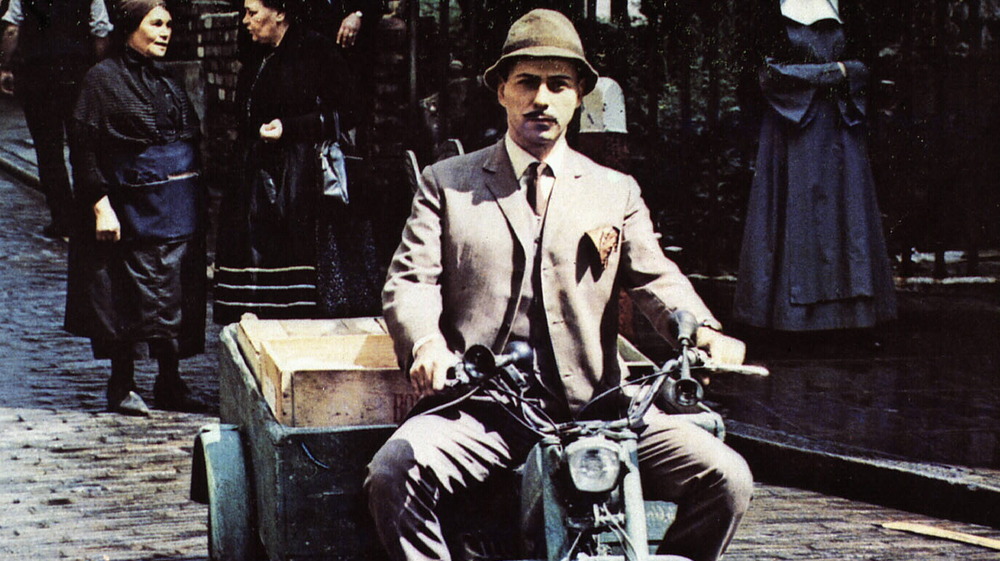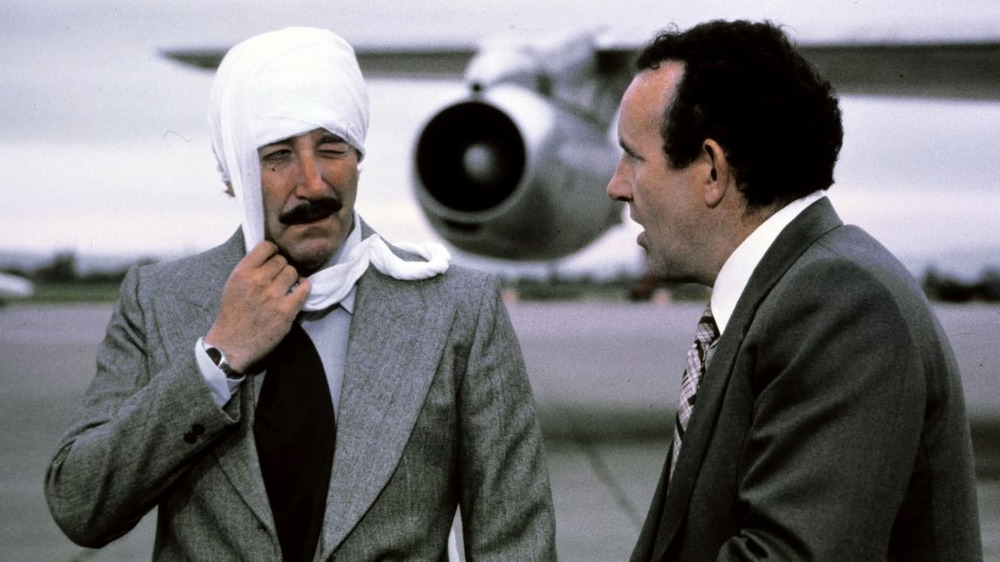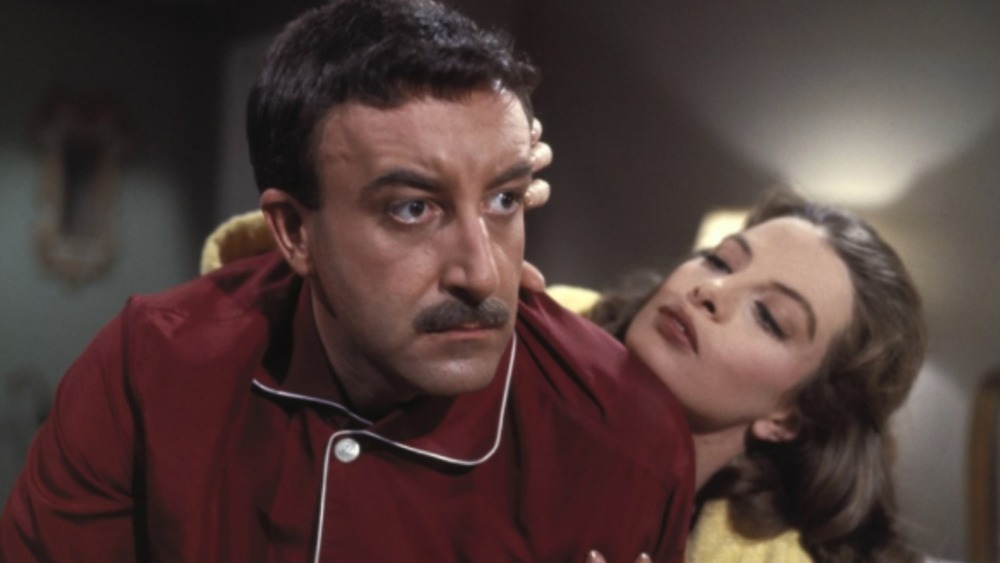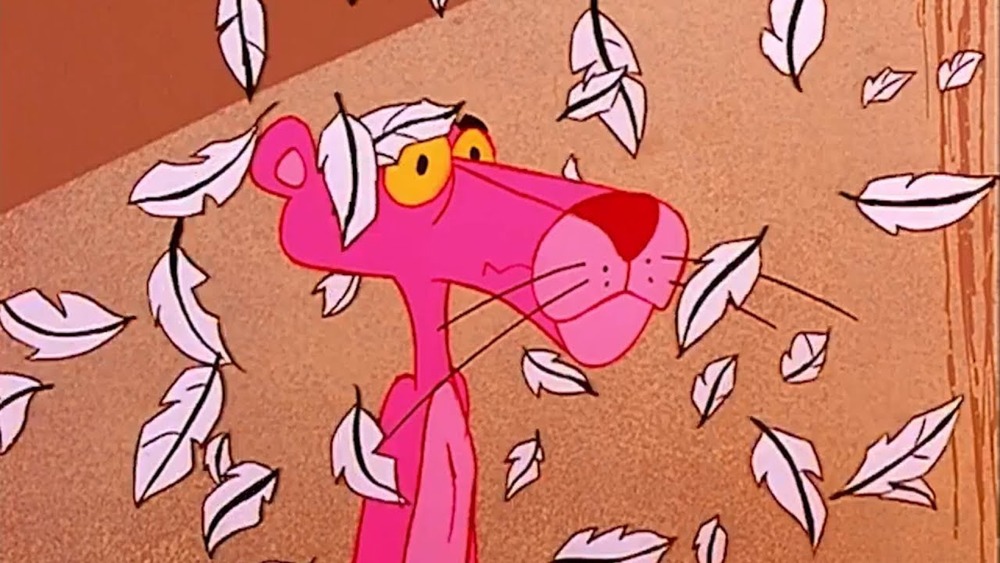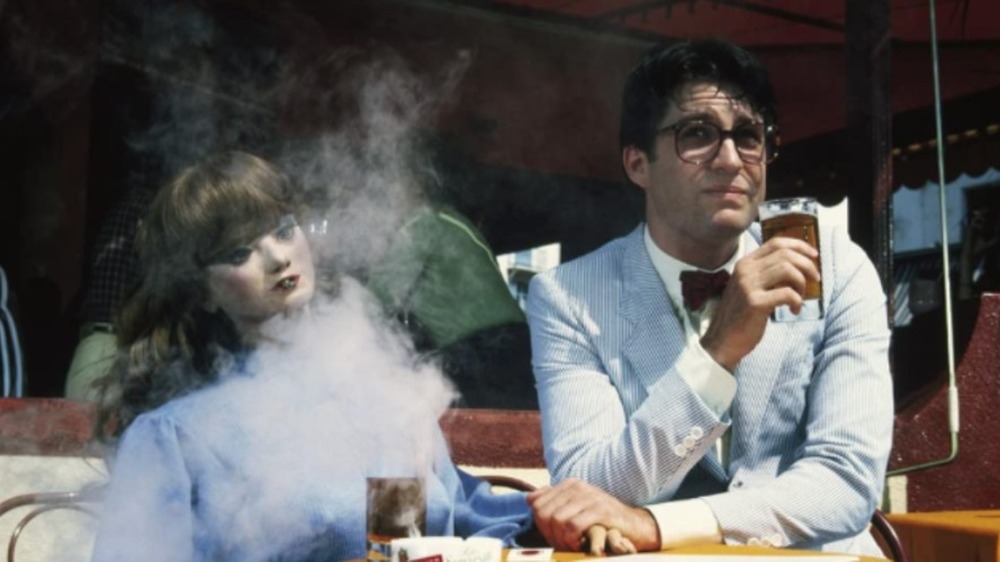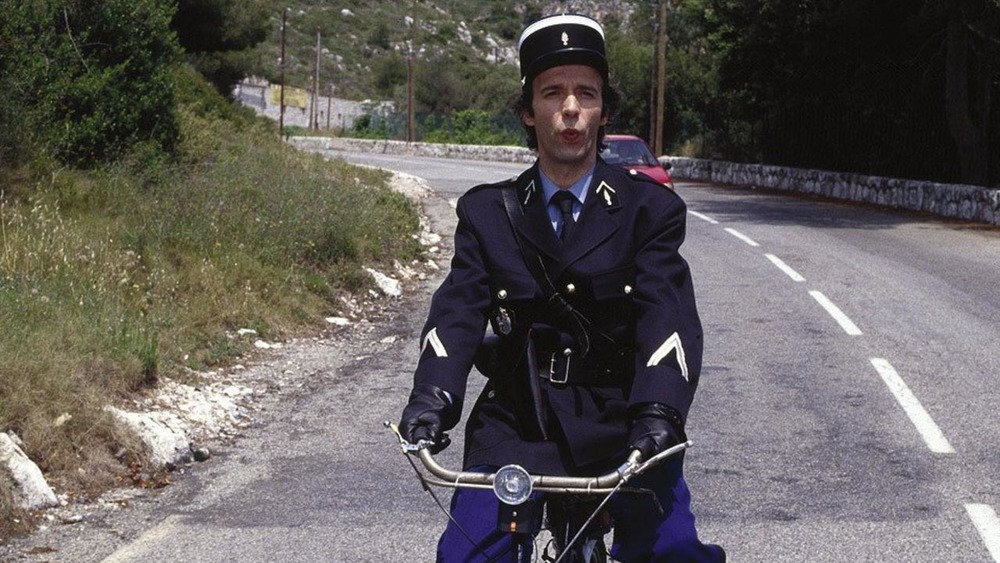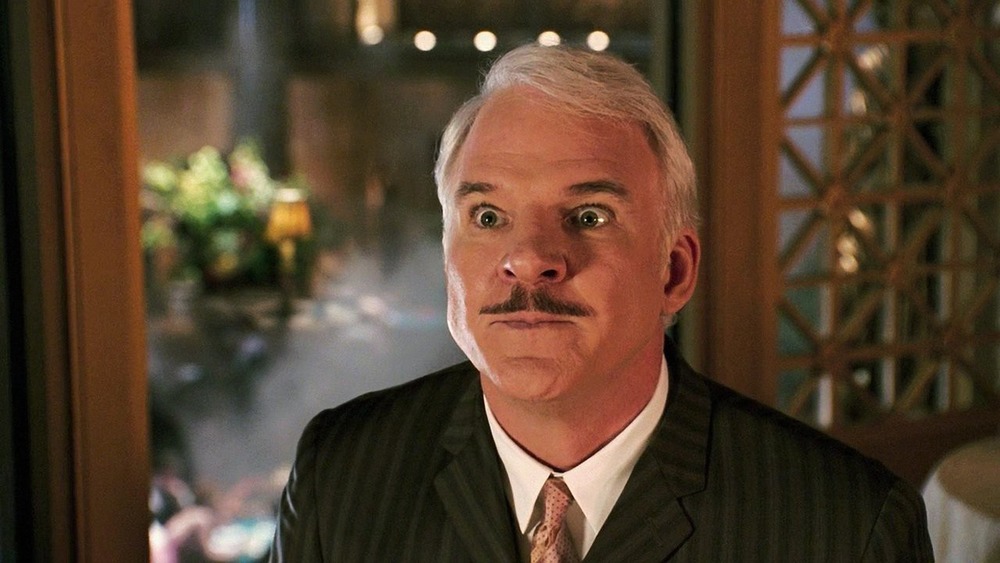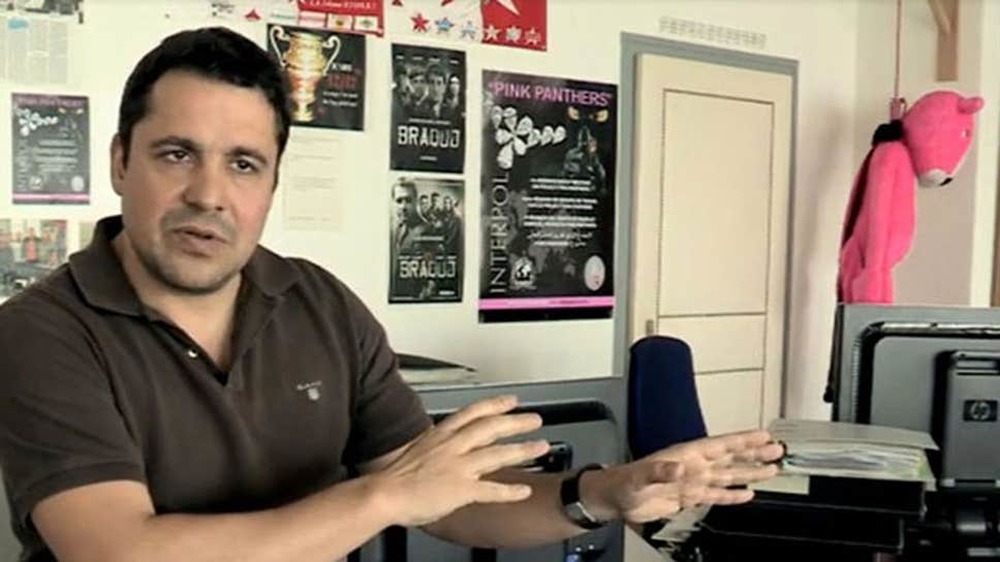The Untold Truth Of The Pink Panther
Even if you're not a fan, there's a good chance you've heard of the Pink Panther franchise. Maybe you're more familiar with cartoons featuring the eponymous feline. Maybe Steve Martin's antics introduced you to the series. Or maybe your interests go deeper, to when the late Peter Sellers made audiences roar with laughter at the antics of Inspector Clouseau.
The Pink Panther series is one of the most enduring comedy franchises, beginning with the 1963 hit The Pink Panther, a film about an infamous jewel thief, his quest to steal the priceless diamond after which the series is named, and Clouseau's mission to stop the heist. Starting with 1964's A Shot in the Dark, Clouseau and the series' other recurring characters proved popular enough to spawn eight sequels, with the final one releasing 30 years after the original's premiere. The films also inspired a popular animated series based on the pink cartoon panther who appeared in the credits of the live-action films. Of course, the 21st century brought a new Inspector Clouseau, and there's more Pink Panther media to come.
But as hilarious as many of the films are, there wasn't always a lot of laughter behind the camera. Actors and directors suffered unique slices of hell to get The Pink Panther and its many follow-ups made, and at the series' heart was one of cinema's most tragic figures. For those stories and more, keep reading for the untold truth of the Pink Panther.
Peter Sellers, the tragic star of The Pink Panther
While the franchise would eventually move on without him to support it, six of the first seven Pink Panther films owed much of their success to the talent of the eccentric and turbulent Peter Sellers, whose lifestyle choices ranged from the bizarre to the horrifically self-destructive, the latter of which likely had something to do with his early death.
Sellers suffered his first heart attack at the age of 38, just two months into his marriage with his second wife — Swedish actress Britt Ekland, who was 21 at the time. It's more than likely substance abuse contributed to his heart's precarious position. Not only was Sellers known to regularly abuse cocaine and alcohol, but both Sellers and his young wife would regularly consume amyl nitrite — better known as "poppers" — to enhance their performance in bed.
Sellers' heart condition would continue to be an issue until his death, and his erratic behavior likely did little to help. Along with his substance abuse, Sellers preferred alternative methods of care, such as his daily sessions with a psychic. In more recent years, Sellers' ex-wife, Ekland, has said she suspected he suffered from undiagnosed bipolar disorder. His infamous behavior on and off movie sets would certainly hint at some kind of serious mental health issues, including bragging about a — by all accounts — imaginary love affair with Sophia Loren and his belief that he was in psychic contact with the dead comedian Dan Leno.
Inspector Clouseau wasn't always the hero of The Pink Panther
While watching 1963's The Pink Panther – the premiere film in the series — you may notice something that seems strange. For the first half of the film, Peter Sellers' Inspector Clouseau hardly shows up at all. Instead, most of the focus is on the late David Niven, who portrays Sir Charles Lytton, an English playboy who's secretly the notorious jewel thief known as the Phantom. Sellers doesn't take center stage until the movie's second half, as the bumbling Clouseau who pursues Lytton to stop him from stealing the precious Pink Panther diamond.
The reason Sellers is absent from so much of the film's beginning is that originally, The Pink Panther was meant as a vehicle for Niven. In fact, Niven remains the top-billed actor for the flick, and Sellers was hired for a supporting role. However, filming Sellers' hilarious improvisation convinced director Blake Edwards that he was the real star. Sellers brought a great deal of invention to the character, including choosing his signature raincoat and hat, as well as repurposing a silly accent he'd used on the '50s The Goon Show radio program as Clouseau's voice.
While Niven wouldn't be the main hero in another Pink Panther film, he did reprise the role of Sir Charles twice more — in 1982's Trail of the Pink Panther and the following year's Curse of the Pink Panther. In Trail, Lytton is now married to Lady Simone (Capucine), Clouseau's ex-wife.
Peter Sellers vs. Blake Edwards
Peter Sellers and writer/director Blake Edwards worked together quite a bit. Before Sellers' death in 1980, he and Edwards collaborated on six films — five of the Pink Panther movies and the 1968 comedy The Party. You might imagine the two were close friends, but according to what Edwards told The Express in 2010, you'd be very wrong.
"Sellers was nuts — really nuts," Edwards told The Express. As early as the first Pink Panther film, Edwards vowed to never work with Sellers again. The actor's unpredictable behavior included frequently not showing up for scenes (sometimes because he wasn't happy with the day's horoscope), waking up Edwards with phone calls in the middle of the night to assure him filming would go well the next day "because God had told him how to play it," and carrying on conversations with the dead. In spite of his frequent promises to sever all ties, Edwards continued to work with Sellers only because of the actor's singular talent.
But according to Edwards, Sellers' behavior on set never improved, and their relationship never got better. Describing Sellers' mental state during the filming of 1976's The Pink Panther Strikes Again, Edwards said, "If you went to an insane asylum, and you described the first inmate you saw, that's what Peter had become." Apparently, the hard feelings were mutual. "[Sellers] had a big emotional investment in me but hated that I was so responsible," Edwards said. At one point, the two resorted to only communicating through each others' assistants.
Without Sellers and Edwards, Clouseau was a bomb
When it came time to make the third installment of the Pink Panther series, neither Peter Sellers nor Blake Edwards were available. Their now famous feud had nothing to do with their absences, however. Instead, they were filming The Party, in which Sellers plays an Indian actor who's mistakenly invited to an exclusive Hollywood party. So, Bud Yorkin stepped in as director of 1968's Inspector Clouseau, and Alan Arkin took up the famous titular role.
Clouseau — who's searching for an organized crime mole working within Scotland Yard — is the only recurring character from the series to appear. Even the music of Henry Mancini, who composed the score for the first two films and much of the rest of the series, is nowhere to be found.
Predictably, without the creative team that made the first two films hits, Inspector Clouseau became the first critical and commercial bomb of the Pink Panther series. In his review of Inspector Clouseau, Roger Ebert wrote that while "in [Arkin's] movements and timing, he's Sellers' equal," the actor wasn't given the same caliber of material to work with. As he put it, "Unhappily, Arkin has been given a script not quite up to the two Sellers-Clouseau films."
The seventh Pink Panther film was pieced together from scraps
Suffering a chronic heart condition for years, Peter Sellers died of a heart attack in 1980 at the age of 54, but the entertainment world wasn't quite done with him. Two years after his death, Trail of the Pink Panther was released, with the late Sellers once again starring as the ridiculous Inspector Jacques Clouseau. While new scenes were shot for Trail, most of the film is pieced together using deleted scenes from 1976's The Pink Panther Strikes Again. Edwards had wanted Strikes Again to be a three-hour film, but United Artists forced him to cut it in half, leaving him with a lot to work with in Trail.
Regardless, neither critics nor audiences were pleased with Trail, and it was a commercial bomb. And it wasn't just your average moviegoer who was unhappy. Shortly after Trail's release, Sellers' young widow, Lynne Frederick, sued Blake Edwards, MGM, and United Artists in London's high court — looking for $3 million in damages and hoping to have the film banned. Sellers, Frederick argued, had refused to have outtakes used while he was alive, and therefore, it was his estate — controlled by Frederick — who should have the last say on whether such scenes could be used after his death. The court agreed, awarding Frederick $1 million, while at the same time refusing to ban the film.
The Pink Panther that never was
By the time 1978's Revenge of the Pink Panther was done filming, things between Sellers and Edwards had soured enough that the latter wouldn't return to direct another film. With Edwards out, Sellers co-wrote the script for the Romance of the Pink Panther. For his writing partner, Sellers chose Jim Moloney, who co-wrote Sellers' final film, the 1980 comedy The Fiendish Plot of Dr. Fu Manchu. The story of Romance would've found Inspector Clouseau smitten by the feminine wiles of the cat burglar Anastasia, with Pamela Stephenson attached to play the thief.
Just eight days before Sellers' death, he and Moloney finished a second draft of Romance. Excerpts of the script (via Pink Panther Mania!) reveal among other things that Clouseau would have first shown up in the film disguised as a chair. At some point, his faithful servant, Cato (Burt Kwouk), would leave his employ, predictably leading to one of their famous martial arts battles. The film would also end in the middle of yet another fight between the two — this one immediately following Clouseau's marriage to Anastasia.
The cartoon Pink Panther
One of the more unique aspects of the Pink Panther films is that it popularized an animated character who — in spite of being, literally, a pink panther — has nothing narratively to do with any of the live-action films. With the exception of A Shot in the Dark and Inspector Clouseau, all of the films with Jacques Clouseau feature the pink feline during the opening credits sequence, accompanied by Henry Mancini's iconic score. While the cat had nothing to do with the stories — the "pink panther" referred to a priceless diamond — the animated sequences proved popular enough for the character to get his own spin-off series and films.
The first time the cat took center stage was in the 1964 animated short The Pink Phink – the winner of that year's Oscar for Best Animated Short — in which the titular cat makes a painter's life difficult by replacing all of his blue paint with pink. Five years later, The Pink Panther Show debuted on NBC, and this was followed by a long series of animated shows, the most recent of which was 2010's Pink Panther and Pals.
The cat isn't done, either. In November 2020, news broke that Jeff Fowler — director of Sonic the Hedgehog – had signed on to direct a Pink Panther film with the cat as the hero. Unconfirmed reports indicate the cat will be a detective's imaginary friend.
The American Pink Panther
Hoping he could keep the Pink Panther franchise alive without Peter Sellers, Blake Edwards co-wrote and directed 1983's Curse of the Pink Panther, in which Inspector Clouseau is replaced as the hero by the equally silly American detective Sergeant Clifton Sleigh, played by Ted Wass. The film brought with it the return of a number of recurring characters, including Cato, Clouseau's old boss, Dreyfus (Herbert Lom), and David Niven as Sir Charles Lytton, aka the Phantom. Curse, sadly, proved to be Niven's final film. He died from ALS at the age of 73 a month before Curse's theatrical release.
While Curse marked the introduction of a new hero, Clouseau is far from forgotten. In fact, it's Clouseau's disappearance — depicted in Trail of the Pink Panther – that Sleigh is tasked to solve. Believe it or not, Clouseau does make an appearance. Roger Moore plays the missing chief inspector, who's since had plastic surgery done to disguise himself as the James Bond actor.
As clever and funny as Moore's cameo proves to be, the rest of the film doesn't shine quite so bright. Panned by critics and bombing at the box office, Curse of the Pink Panther shuttered the franchise for a decade.
The son of Clouseau
In 1993, Blake Edwards made one final stab at reviving the Pink Panther series. Edwards cast Italian actor Roberto Benigni as Jacques Gambrelli. Born out of wedlock, Gambrelli is the son of Jacques Clouseau and Maria Gambrelli (Claudia Cardinale) — the murder suspect from A Shot in the Dark. A police officer in the south of France, Gambrelli has yet to earn the equal of his father's reputation, but he's nevertheless pulled into an investigation when he comes across the kidnappers of Princess Yasmin (Debrah Farentino) of the fictional nation of Lugash.
Unfortunately, no one liked Son of Pink Panther anymore than they did its 1983 predecessor, Curse of the Pink Panther. In fact, judging by their different aggregate critic scores on Rotten Tomatoes – Curse's abysmal 29% to Son's hopeless 6%– they were even less impressed, which is arguably a feat unto itself. Just as Roger Ebert did for Alan Arkin's turn at the franchise 25 years earlier in Inspector Clouseau, a number of critics praised Benigni but posited he had little to work with in Son. "I can foresee a future for Benigni in American comedy," Jonathan Rosenbaum wrote for Chicago Reader, "but probably not as Clouseau Junior." Rosenbaum went on to write of Son and the franchise as a whole, "The dead horse [Blake] Edwards has been beating for over a decade finally seems to be turning into a rather sticky glue."
Edwards got the message. Son is the last film in his series, but Clouseau would live again.
Steve Martin, the 21st-century Inspector Clouseau
In 2006, The Pink Panther returned. Instead of introducing a brand new hero, the narrative was rebooted with Steve Martin taking on the role of Inspector Clouseau. Kevin Kline replaced Harold Lom as Chief Inspector Dreyfus, Jean Reno played a cop assigned to spy on Clouseau for Dreyfus, and Beyoncé appears as — who would've guessed — a pop star. Plenty of invested fans were convinced neither Martin nor anyone else should go within 100 miles of Clouseau, including Blake Edwards. In 2003, Edwards commented on the casting to the Los Angeles Times, saying of Martin, "Why put himself in competition with Sellers? He's not even going to come close to Sellers."
While the Rotten Tomatoes aggregate score for The Pink Panther of 21% indicates most critics agreed with Edwards' prediction, audiences apparently felt differently. Making $164 million, 2006's The Pink Panther proved to be the highest-grossing film in the franchise.
Martin returned for the 2009 sequel The Pink Panther 2, along with Jean Reno, though John Cleese replaced Kline as Dreyfus. While both of Martin's Panther films are rated PG, Panther 2 has a decidedly more family-friendly focus. Martin explained to MTV, "The audiences that really liked the first one were families," hence the change. Apparently, that change didn't translate to more ticket sales, as not only did critics hate Panther 2 even more than the first film, but it barely broke even at the box office.
The real-life Pink Panthers
Whether you call it life imitating art or just popular culture changing how we see real life, the Pink Panther franchise helped to name some of the world's most notorious thieves.
The crimes of an alleged international network of jewel thieves became much more well-known when the acclaimed documentarian Havana Marking researched the subject for her 2013 film Smash & Grab: The Story of the Pink Panthers. Smash & Grab tells the story of this network named after the film franchise with interview footage of professionals pursuing the group, as well as some people claiming to be members, closed-circuit recordings of actual heists, and fictionalized accounts of other thefts.
One of the most stunning pieces of footage in Smash & Grab gives a good example of how efficient its subjects are. Security footage shows some of the alleged Pink Panthers driving two Audis through the doors of a mall in Dubai and stealing $4 million worth of jewelry in under 2 minutes.
